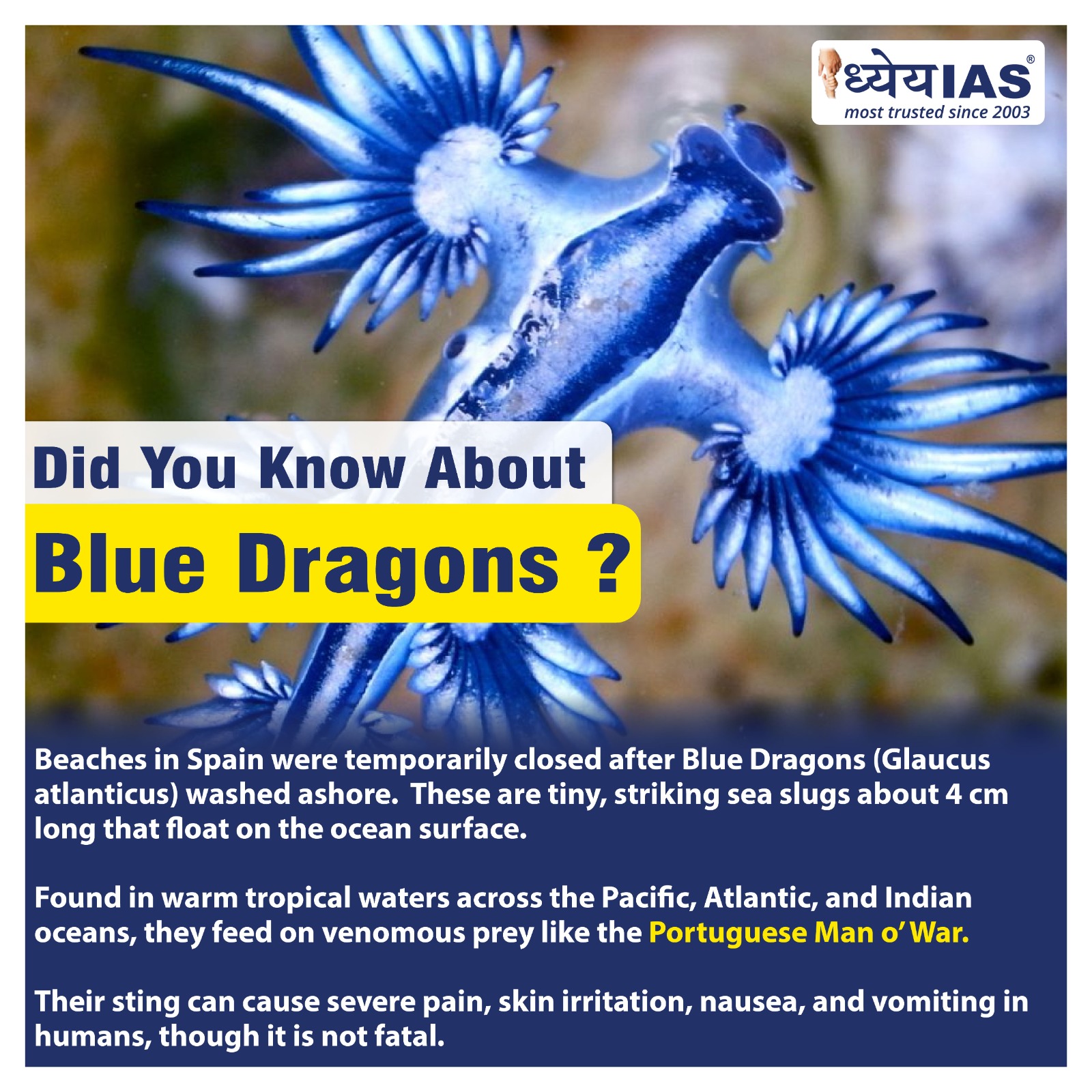Context:
Recently, several beaches in Spain were temporarily closed following an unexpected invasion of Blue Sea Dragons (Glaucus atlanticus) — a rare and striking species of sea slug. Authorities issued warnings after multiple sightings raised public safety concerns, particularly due to the creature’s stinging capabilities.
About Blue Dragons:
The blue sea dragon (Glaucus atlanticus) is a small, venomous sea slug that floats upside down on the ocean surface, using a gas-filled sac to stay afloat.
· They inhabit tropical and temperate waters of the Atlantic, Pacific, and Indian Oceans. Unlike many other sea creatures, they do not swim actively but drift with the waves. Interestingly, they are hermaphrodites, possessing both male and female reproductive organs.
· These creatures feed on venomous siphonophores, especially the Portuguese man-o-war and bluebottle jellyfish.
· Rather than being harmed by the venom, the blue dragon harvests the stinging cells (nematocysts) from its prey and stores them in specialized structures called cerata on its body.
· This makes them highly toxic to predators, even though they are not venomous themselves.
Reason for appearance:
- Though usually found in tropical waters, sightings of blue dragons in Spain are increasing, likely due to rising sea temperatures in the Mediterranean.
- Warmer waters may be attracting their jellyfish prey closer to shore, bringing the blue dragons along.
- The Mediterranean Sea is among the world’s fastest-warming water bodies, with recent temperatures exceeding 28°C — nearly 5°C above normal in some regions.
About Sea Slugs (Nudibranchs)
Sea slugs, commonly known as nudibranchs, are soft-bodied marine molluscs that inhabit all the world’s oceans—from shallow waters to the deep sea. Belonging to the Phylum Mollusca and Class Gastropoda, they resemble naked snails, as they lack an external shell.
Habitat and Role in Ecosystems
Sea slugs are usually found in coral reef environments, where they play a key role as indicators of reef health. Their presence often reflects the strength of a coral ecosystem. These slow-moving grazers feed on algae, sponges, and small invertebrates, exhibiting diverse feeding habits.
Defence and Toxicity
Renowned for their vibrant colours and patterns, sea slugs use visual warning signals to deter predators. Their toxicity often comes from the prey they consume—some can even retain stinging cells from jellyfish for self-defence.
Unique Biological Traits:
Sea slugs showcase fascinating adaptations. Some species can:
· Photosynthesise by using sunlight to produce food.
· Regenerate lost limbs.
· Steal genes from prey and integrate them into their DNA (a rare trait in animals).
While most are diurnal, some species are also nocturnal.
Conclusion:
The presence of blue dragons (Glaucus atlanticus) on Spanish coastlines, where they are not typically found, is considered a worrying sign of marine ecosystem changes. These creatures, which normally inhabit warm tropical waters, are appearing in the Mediterranean due to rising sea temperatures linked to climate change. Their expansion poses risks to native species and highlights the broader impacts of global warming on marine environments.







